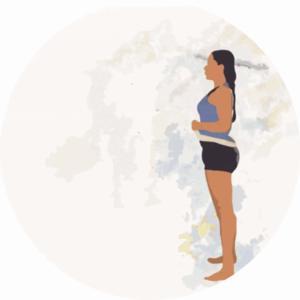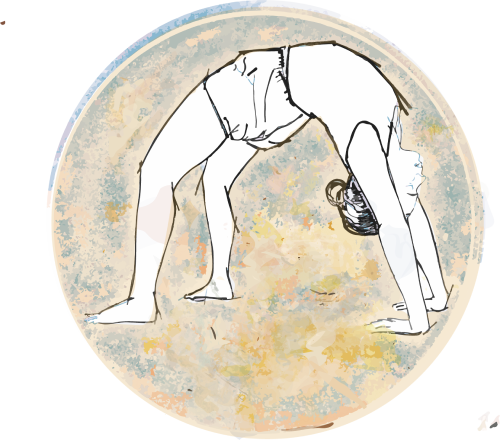[vc_row][vc_column][vc_column_text]“I am not in my father’s shadow, I am in my father’s light.”
This begins the yoganusasanam 2015 summary written by Parizad Z – teacher, mentor, friend (published in the most recent yoga rahasya and very kindly forwarded to us by parizad)
As parizad says in this article, it is possible to gather the technicalities form the DVD, but to get a sense of the aura we were enveloped in for those few days, read this.
“I am not in my father’s shadow, I am in my father’s light.”
Geetaji’s famous words were yet again proved true when she stepped on stage at Yoganusasanam 2015. That light shone brighter than ever from her, showing us the courage and faith of her conviction in her father’s, and later her own, chosen path – Yoga.
The eldest of Guruji Yogacharya BKS Iyengar’s 6 children, besides being in his light, has also been in the harsh glare of a true Master’s gaze. When she reminisces about her family’s journey into, through and with yoga, you can actually visualize a little girl learning devotedly at her father’s feet (literally). You unwittingly recoil when she tells you how her teacher gave her a sudden, sharp kick in shirsasana. You feel the weight of responsibility on her slender but strong shoulders, to carry forth a larger-than-life legacy. Yes, she came into the spotlight but that was after being put in a spot and then being spot-on through lots of trial-and-tribulations in her own sadhana. Geetaji’s transition into a Yoga Guru in her own right, has been a long and arduous journey, peppered with road-blocks and speed bumps, like a life-threatening kidney condition and an equally (if not more) life-changing episode – the sad demise of her mother at a young age.
But why is all this relevant now? This is not Geeta Iyengar’s biography but a write-up on the Annual yoga camp Yoganusasanam 2015 (now in its 2nd year), held at Balewadi, Pune, Maharashtra, India. The 1,200 Iyengar Yoga students gathered from 52 countries will tell you why. All the years of training, sweat, study, hardship were churned and distilled and what Geetaji gave the students was the pure nectar of her teaching. So then, to understand her teaching now, one also has to understand the trajectory of her path.
On December 7, 2015 when this diverse group of students came together, stood on their yoga mats and faced the stage, they were all one, as students of the subject. The anusasanam – discipline, reflected in every aspect, from the smooth organization of the event (from ID cards, prop kits, color-coded groups to the well laid-out stalls for yoga merchandise) to the orderly assembling of the students.
Day 1 commenced, as always, with lighting of the lamp and the invocation to Sage Patanjali and our Gurus. We don’t need to recall and transcribe every
word Geetaji said, for that we can always watch the DVD. What we need to remember and imbibe is the essence, ethos and spirit with which she taught, through example and correction of those on stage and off it…but most importantly, what she taught through empathy. Faced with a motley group of students, some ranging from 3 years to 40 + years of IY practice, no problem was too difficult, no doubt was too petty, no correction was too complex once she identified it. Her adjustments, through her student-teachers or with her own hands, showed us the difference between just knowing the subject and living it…and wholeheartedly sharing these experiences with all to keep this knowledge alive.
The students, in the beginning all eager, expectant, anxious, excited and some plain nervous, were introduced to discipline, precision, alignment and ingenuity, the true Iyengar way. “Don’t die and stay,” she said humorously,
“…no use staying there like dead bodies…instead, do and die.”
Juxtaposed with Geetaji’s teaching, the ‘after class’ programs organized by Abhijata and her team, were always educative, informative and even entertaining. Abhi’s keen extrapolation on the relevance-importance of props in Iyengar yoga, through video and live demonstration, was linked with some personal anecdotes of lessons with Guruji.
Prashantji’s dissection of ‘Yogasadhana and Naada-sadhana’ read out by a student, threw light on the jugalbandi (literal meaning: entwined twins) between two very potent arts – yoga and music (or primordial sound vibrations). It helped music aficionados and even non-initiates grasp the deeper, subtle yet extremely insightful observations made by him.
It also made us aware of how multi-faceted, multi-faced and multifarious this subject of yog really is.
All this was further magnified when we “revisited Guruji’s class” in Panchgani, 1993. The recorded class gave all a glimpse of Guruji’s exacting style of teaching, his eye for detail and penchant for perfection. Geetaji’s presence on the dais to simplify and explain the nuances of his teaching, added an element of interest to fuel our curiosity. The next day some of his direct pupils ignited our imagination further by introducing us to a quote of Guruji, selected by each one to reminisce about or to elucidate the finer, hidden meanings and connections. Our beloved Guruji put it simply but succinctly when he said, “Yoga is not a religion but a science of religion which helps us understand our religion better.” Patxi Lizardi, Birju Mehta, Zubin Zarthoshtimanesh and Eddie Marks’ oratory exploration of not just their Guru but topics hitherto untouched (religion, faith) meant that our community has indeed come of age. On another day, Manouso Manos, Rita Keller, Rajvi Mehta shared experiences of teaching IY. Their often poignant and sometimes humorous recounting of episodes and incidents while teaching a displaced diaspora in Bhuj, eager children in Bellur or menacing inmates in prisons made us either roll in the aisles or knowingly roll our eyes; but for sure, a tear was shed by all, whether in mirth or memory.
The violin rendition by Atul Upadhyay proved that music indeed, is the universal language and unites all. The receptive audience, even after the hearty meal, was hungry for more. We discussed and exchanged everything, from yoga class notes to musical notes!
In that vast space where the classes were conducted, you could try and hide but you could not avoid Geetaji’s sharp, darting eyes…and feel Guruji’s omnipresence, inspiring us even visually, through the strategically placed asana-pranayama banners (banners & audio-visual coordination – all credit to Raya & team). Geetaji’s perceptive and experiential knowledge of every action in every asana and in every breath even, took us through myriad feelings and emotions in our practice. She made us understand what asana for asana, asana for pranayama and asana for dhyana actually entailed. Without verbalizing it even, all through the week she made us experience the tapa in tapasya, thus enabling us to organically try and transcend towards the state of dharna and dhyana. “…force of will cannot be used to do pranayama. We can only go as far and as fast/slow as the body, mind and breath are ready.” Geetaji’s approach to constructively teaching Pranayama was similarly inspired and instinctive, our collective jumps or collective inhalations/exhalations would tell her everything about how much energy her students were expending or conserving. It was ultimately each one’s individual journey on this path, where we were walking alone as a crowd.
Progressively, as we all tried to fathom this ‘no pain, no gain’ condition, the message was that hope and salvation lay only through svadhyay and sadhana. The point is that although we were feeling fortunate in being in that class in Pune, it was not just about location, location and location but primarily about practice, practice and practice.
All through, Geetaji had her finger on our pulse, nerves and nadis. The 2 demonstrators on stage were performing next to her but she was performing next to each and every one of us – as a mentor, guide and even mother. Geetaji would correct, chide and coerce us into stretching our limits and reaching for the horizon, infusing in us a sense of wonder at what ‘we’ were capable of achieving. Like a child taking his first few baby steps holding his mother’s hand looks up in triumph, on the last day we too looked up with awe at the baby steps and giant leaps our actions, understanding and intelligence had taken within us.
Geetaji had labored and we were reborn.
(Parizad Zarthoshtimanesh)[/vc_column_text][/vc_column][/vc_row]





